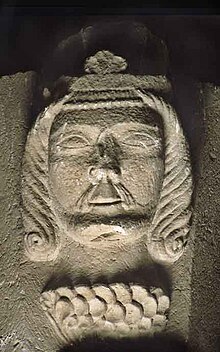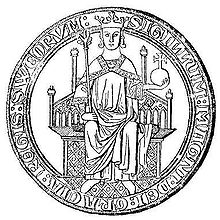| Revision as of 13:15, 24 June 2024 editSergeWoodzing (talk | contribs)Autopatrolled, Extended confirmed users, Pending changes reviewers, Rollbackers24,284 edits His grandson who was beheaded is normally called "Magnus Birgersson" - very rarely this man← Previous edit | Revision as of 13:16, 24 June 2024 edit undoSergeWoodzing (talk | contribs)Autopatrolled, Extended confirmed users, Pending changes reviewers, Rollbackers24,284 edits we do not know thatNext edit → | ||
| Line 33: | Line 33: | ||
| |title= Magnus Birgersson 'Ladulås' |publisher= Pennan & Svärdet |author= Ulf Sundberg |date= 1999 |access-date=January 1, 2019|archive-url= https://web.archive.org/web/20190320150611/https://www.pennanochsvardet.se/militarhistoria/svenskakrig/krig-1222-1388/magnus-birgersson-ladulas|archive-date=March 20, 2019}}</ref> | |title= Magnus Birgersson 'Ladulås' |publisher= Pennan & Svärdet |author= Ulf Sundberg |date= 1999 |access-date=January 1, 2019|archive-url= https://web.archive.org/web/20190320150611/https://www.pennanochsvardet.se/militarhistoria/svenskakrig/krig-1222-1388/magnus-birgersson-ladulas|archive-date=March 20, 2019}}</ref> | ||
| He was |
He was a son of ], and became a king after a rebellion against his brother ]. He was succeeded by his ten-year-old son ] with ] acting as his guardian. | ||
| Medieval Swedish kings did not use ] as part of their title.<ref>{{Cite book |last=Lagerqvist |first=Lars O. |url=http://archive.org/details/kingsrulersofswe0000lage |title=Kings and rulers of Sweden : a pocket encyclopedia |date=1995 |publisher=Stockholm, Sweden : Vincent Publications |others=Internet Archive |isbn=978-91-87064-15-9 |pages=5}}</ref> In modern literature he may be referred to as either '''Magnus I'''<ref>{{Cite web |date=2024-03-25 |title=Magnus I {{!}} Viking Age, Reformer & Lawgiver |url=https://www.britannica.com/biography/Magnus-I |access-date=2024-04-26 |website=Encyclopedia Britannica |language=en}}</ref> or '''Magnus III'''.<ref>{{Cite book |last=Lagerqvist |first=Lars O. |url=http://archive.org/details/kingsrulersofswe0000lage |title=Kings and rulers of Sweden : a pocket encyclopedia |date=1995 |publisher=Stockholm, Sweden : Vincent Publications |others=Internet Archive |isbn=978-91-87064-15-9 |pages=22}}</ref><ref>'']'' pp. 22-23, 106</ref> | Medieval Swedish kings did not use ] as part of their title.<ref>{{Cite book |last=Lagerqvist |first=Lars O. |url=http://archive.org/details/kingsrulersofswe0000lage |title=Kings and rulers of Sweden : a pocket encyclopedia |date=1995 |publisher=Stockholm, Sweden : Vincent Publications |others=Internet Archive |isbn=978-91-87064-15-9 |pages=5}}</ref> In modern literature he may be referred to as either '''Magnus I'''<ref>{{Cite web |date=2024-03-25 |title=Magnus I {{!}} Viking Age, Reformer & Lawgiver |url=https://www.britannica.com/biography/Magnus-I |access-date=2024-04-26 |website=Encyclopedia Britannica |language=en}}</ref> or '''Magnus III'''.<ref>{{Cite book |last=Lagerqvist |first=Lars O. |url=http://archive.org/details/kingsrulersofswe0000lage |title=Kings and rulers of Sweden : a pocket encyclopedia |date=1995 |publisher=Stockholm, Sweden : Vincent Publications |others=Internet Archive |isbn=978-91-87064-15-9 |pages=22}}</ref><ref>'']'' pp. 22-23, 106</ref> | ||
Revision as of 13:16, 24 June 2024
King of Sweden from 1275 to 1290 "Magnus Birgersson" redirects here. For the Swedish electronic music artist, see Solar Fields.| Magnus Ladulås | |
|---|---|
 Bust of Magnus as duke at Skara Cathedral Bust of Magnus as duke at Skara Cathedral | |
| King of Sweden | |
| Reign | 1275 – 18 December 1290 |
| Predecessor | Valdemar |
| Successor | Birger |
| Born | c. 1240 |
| Died | 18 December 1290 (aged c. 50) |
| Burial | Riddarholm Church |
| Spouse | Helwig of Holstein |
| Issue more... | |
| House | Bjelbo |
| Father | Birger Jarl |
| Mother | Ingeborg Eriksdotter of Sweden |



Magnus Ladulås (pronounced [l'ɑːdɵloːs], lit. 'Barnlock') or Magnus Birgersson, (c. 1240 – 18 December 1290), was King of Sweden from 1275 until his death in 1290.
He was a son of Birger Jarl, and became a king after a rebellion against his brother Valdemar. He was succeeded by his ten-year-old son Birger Magnusson with Torkel Knutsson acting as his guardian.
Medieval Swedish kings did not use regnal numbers as part of their title. In modern literature he may be referred to as either Magnus I or Magnus III.
Epithet
The origin of the epithet Ladulås (lit. 'Barnlock') is not known for certain, due to the lack of source material from the latter half of the 14th century. It appears widely in written documents from the beginning of the 15th century, with the Visby Chronicle from 1412 being the oldest datable document. Lilla rimkrönikan from c. 1450 gives the traditional explanation, ascribing the epithet to the Ordinance of Alsnö. This act by Magnus freed the yeomanry from the duty to provide sustenance for travelling nobles and bishops, and "locked the barns".
Another theory is that Ladulås is a corruption of a second name Ladislaus, the Latin equivalent of the Slavic name Vladislav. (Magnus's maternal great-grandmother was Sophia of Minsk, a Rurikid princess.)
Early life
Magnus was born c. 1240 as the second son of Birger Jarl (1200–66) and Princess Ingeborg, herself the sister of the childless King Eric XI and daughter of King Eric X. The early life of Magnus is poorly documented, but he seems to have received an extensive education.
King Eric XI ruled until 1250. After his death, Magnus' elder brother Valdemar (1239–1302) became king, but the true power was held by his father Birger Jarl who acted as a regent. In 1255, Magnus was granted the title of a iunior dux, 'junior jarl'.
When Birger died in 1266, Magnus assumed his title as the Duke of Sweden. The title was not accompanied by any unified territory, but by a number of scattered estates and rights to collect taxes and fines. He also received Nyköping Castle in Södermanland.
There is no indication that he would have received the powers of his father. According to the Eric Chronicle, Magnus wanted to share the Royal power with his brother, which led to a conflict.
Accession and marriage
In 1275, Duke Magnus started a rebellion against Valdemar, supported by his younger brother Eric and King Eric Klipping of Denmark. Valdemar was deposed by Magnus after the Battle of Hova in the forest of Tiveden on 14 June 1275 with the help of Danish and German horsemen. In July, Magnus was elected king at the Stones of Mora.
In 1276, Magnus allegedly married a second wife Helwig, daughter of Gerard I of Holstein. Through her mother, Elizabeth of Mecklenburg, Helwig was a descendant of Christina, the putative daughter of King Sverker II. A papal annulment of Magnus' alleged first marriage and a dispensation for the second (necessary because of consanguinity) were issued ten years later, in 1286. Helwig later acted as regent, probably 1290–1302 and 1320–1327.
Reign
The deposed King Valdemar managed, with Danish help in turn, to regain provinces in Gothenland in the southern part of the kingdom, and Magnus had to recognize that in 1277. However, Magnus regained them about 1278 and assumed the additional title rex Gothorum, King of the Goths, starting the tradition of "King of the Swedes and the Goths".
King Magnus's youngest brother, Bengt (1254–1291), then archdeacon, acted as his Lord High Chancellor of Sweden, and in 1284 Magnus rewarded him with the Duchy of Finland.
Magnus died when his sons were yet underage. Magnus ordered his kinsman Torkel Knutsson, the Lord High Constable of Sweden as the guardian of his heir, the future King Birger, who was about ten years old at father's death.
Modern research
In spring 2011, archaeologists and osteologists from the University of Stockholm were granted permission to open one of the royal tombs in the Riddarholmen Church, traditionally believed to contain the remains of Magnus Ladulås and some of his relatives. A thorough osteological and odontological examination revealed the presence of five male and two female skeletons. Preliminary studies indicated a notable sickly disposition in one skeleton, previously presumed to belong to Magnus Ladulås based on descriptions of his ailments. Contrary to expectations, radiocarbon dating indicated that the skeletons were from the 15th and early 16th centuries, and could not belong to the king and his family.
In 2012, the research team was permitted to open the adjacent tomb, traditionally believed to contain King Karl Knutsson. Thus, the results showed that these remains were from the 15th and early 16th century. The location of Magnus Ladulås's grave remains unresolved. In 2014, the team discovered a previously unknown brick chamber between the two tombs, but further excavation was halted due to legal and administrative challenges.
Issue
From his alleged first (annulled) marriage to an unknown woman:
- Eric Magnusson (born c. 1275 – c. 1277)
From his second marriage to Helwig of Holstein:
- Ingeborg Magnusdotter of Sweden (born c. 1279); married King Eric VI of Denmark.
- Birger, King of Sweden (born c. 1280)
- Eric Magnuson, Duke of Sudermannia in 1302 and Halland etc. c 1305, born c. 1282. Died of starvation in 1318 at Nyköpingshus Castle while imprisoned by his brother King Birger.
- Waldemar Magnuson, Duke of Finland in 1302 and Öland 1310. Died of starvation 1318 at Nyköpingshus Castle while imprisoned by his brother, King Birger.
- Richeza Magnusdotter of Sweden (d. after 1347), Abbess of the convent of St. Clare's Priory, Stockholm.
References
- Ulf Sundberg (1999). "Magnus Birgersson 'Ladulås'". Pennan & Svärdet. Archived from the original on March 20, 2019. Retrieved January 1, 2019.
- Lagerqvist, Lars O. (1995). Kings and rulers of Sweden : a pocket encyclopedia. Internet Archive. Stockholm, Sweden : Vincent Publications. p. 5. ISBN 978-91-87064-15-9.
- "Magnus I | Viking Age, Reformer & Lawgiver". Encyclopedia Britannica. 2024-03-25. Retrieved 2024-04-26.
- Lagerqvist, Lars O. (1995). Kings and rulers of Sweden : a pocket encyclopedia. Internet Archive. Stockholm, Sweden : Vincent Publications. p. 22. ISBN 978-91-87064-15-9.
- Centuries of Selfies pp. 22-23, 106
- ^ Schück, Herman. "Magnus Birgersson". Svenskt Biografiskt Lexikon. Retrieved 2024-04-25.
- ^ Moberg, Vilhelm (2005). A history of the Swedish people. Minneapolis: University of Minnesota Press. p. 94. ISBN 978-0-8166-4656-2.
- ^ Line, Philip (2006). Kingship and state formation in Sweden, 1130-1290. Leiden: Brill. pp. 131–134. ISBN 978-90-04-15578-7.
- Suvanto, Seppo (23 June 2000). "Maunu Ladonlukko". Kansallisbiografia. Studia Biographica 4. Helsinki: Suomalaisen Kirjallisuuden Seura. ISSN 1799-4349. Retrieved 26 April 2024.
- ^ Huldén, Lena (December 2014). "Magnus Ladulås". Biografiskt lexikon för Finland. Retrieved 2024-04-26.
- "Mora Stenar". knivstashistoria.se. Retrieved January 1, 2019.
- Sten Engström. "Bengt Birgersson". Svenskt biografiskt lexikon. Retrieved January 1, 2019.
- ^ Annerbäck, Lin; Vretemark, Maria (2015). "Sökandet efter Magnus Ladulås". Årsbok 2015 KVHAA (in Swedish). Kungl. Vitterhets Historie och Antikvitets Akademien: 51–62. ISBN 978-91-7402-441-8.
- "Magnus Ladulås gravöppningsblogg - Dagbok för forskningsprojektet kring Magnus Ladulås och hans anhöriga". magnusladulas.blogg.se. Retrieved 2024-06-23.
External links
 Media related to Magnus III of Sweden at Wikimedia Commons
Media related to Magnus III of Sweden at Wikimedia Commons
| Magnus LadulåsHouse of BjelboBorn: 1240 Died: 18 December 1290 | ||
| Regnal titles | ||
|---|---|---|
| Preceded byValdemar | King of Sweden 1275–1290 |
Succeeded byBirger |